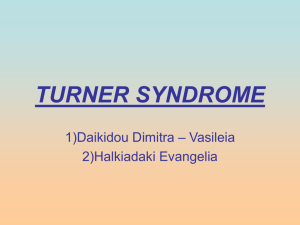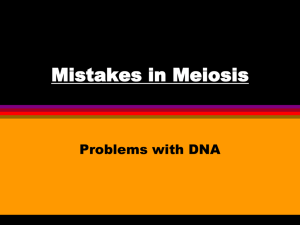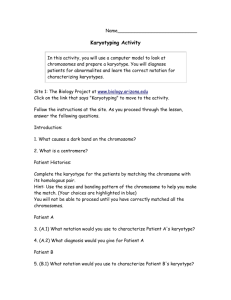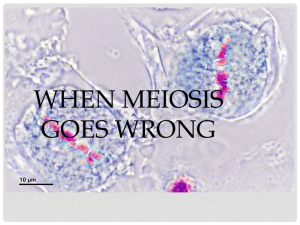JEOPARDY - TXStateDPT2012
advertisement
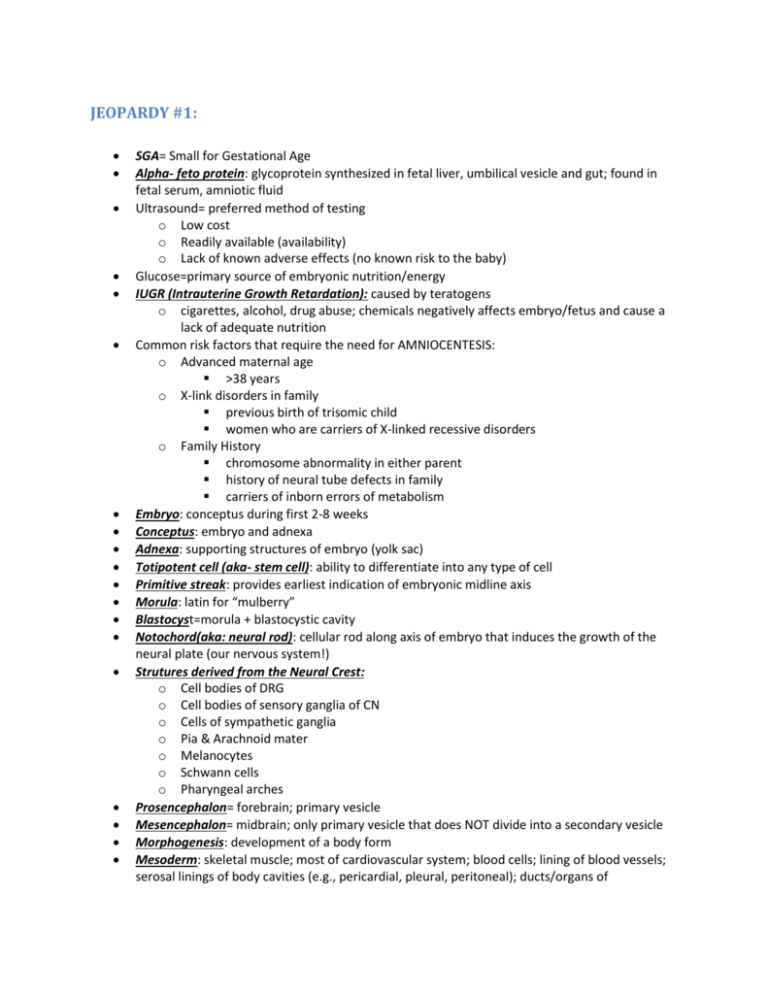
JEOPARDY #1: SGA= Small for Gestational Age Alpha- feto protein: glycoprotein synthesized in fetal liver, umbilical vesicle and gut; found in fetal serum, amniotic fluid Ultrasound= preferred method of testing o Low cost o Readily available (availability) o Lack of known adverse effects (no known risk to the baby) Glucose=primary source of embryonic nutrition/energy IUGR (Intrauterine Growth Retardation): caused by teratogens o cigarettes, alcohol, drug abuse; chemicals negatively affects embryo/fetus and cause a lack of adequate nutrition Common risk factors that require the need for AMNIOCENTESIS: o Advanced maternal age >38 years o X-link disorders in family previous birth of trisomic child women who are carriers of X-linked recessive disorders o Family History chromosome abnormality in either parent history of neural tube defects in family carriers of inborn errors of metabolism Embryo: conceptus during first 2-8 weeks Conceptus: embryo and adnexa Adnexa: supporting structures of embryo (yolk sac) Totipotent cell (aka- stem cell): ability to differentiate into any type of cell Primitive streak: provides earliest indication of embryonic midline axis Morula: latin for “mulberry” Blastocyst=morula + blastocystic cavity Notochord(aka: neural rod): cellular rod along axis of embryo that induces the growth of the neural plate (our nervous system!) Strutures derived from the Neural Crest: o Cell bodies of DRG o Cell bodies of sensory ganglia of CN o Cells of sympathetic ganglia o Pia & Arachnoid mater o Melanocytes o Schwann cells o Pharyngeal arches Prosencephalon= forebrain; primary vesicle Mesencephalon= midbrain; only primary vesicle that does NOT divide into a secondary vesicle Morphogenesis: development of a body form Mesoderm: skeletal muscle; most of cardiovascular system; blood cells; lining of blood vessels; serosal linings of body cavities (e.g., pericardial, pleural, peritoneal); ducts/organs of reproductive system (e.g., ovaries, testes, genital ducts, kidneys); connective tissue; cartilage/bones/tendons/ligaments Cranial to caudal: head to toe Gastrulation: process that creates the 3 germ layers, bilaminar, & trilaminar embryonic discs Syncytiotrophoblast: rapidly expanding multi-nucleating mass that supports cells as embryo developing Somites: creates axial skeleton & associated musculature Chromatid: half of a chromosome Acrosome: saccular organelle of the sperm whose insides contain enzymes that penetrate the zona pellucid Spongy layer of the endometrium of the uterus= dementious connective tissue layer containing dilated tortuous bodies of the uterine gland Oocyte: massive, immobile gamete Uterine tubes: fallopian tubes Nondisjunction: failure of paired chromatids to separate; error in cell division in which there is failure of chromosomal pair or two chromatids of a chromosome to disjoin during mitosis or meiosis Mittelschmertz: abdominal pain during ovulation Corpus luteum: secretes progesterone and estrogen allowing endometrium to prepare for implantation X-sperm: 2.8% more DNA found in this sperm Compaction: blastomeres coming close together to form a ball Trophoblast: the embryonic part of the placenta Zona pellucida: amorphosis, acellular glycoprotein covering Mesoblast: undifferentiated mesoderm Jeopardy #2 Percentage of congenital anomalies where etiology is unknown= 50-60% Rubella virus: causes severe anatomical anomalies (e.g., cardiac defects, deafness, cataracts) when present during critical period of development of eyes, heart, ears External Ear Defect= An example of a minor anomaly that may indicate presence of a major anomaly in the kidneys (aka: what is a hairy daddy ) Autosomes: NON-sex chromosomes Ratio of chromosomal abnormalities: 1 in 120 live births Malformation: morphologic defect of an organ, part of an organ, or larger region of the body that results from an intrinsically abnormal developmental process (e.g., chromosomal abnormality of a gamete at fertilization…mutations from the baby) Disruption: morphologic defect of an organ, part of an organ, or larger region of the body that results from extrinsic breakdown of, or an interference with, an originally normal developmental process (e.g., radiation, drugs, viruses, not enough amniotic fluid…external to cell structure); can NOT be inherited but inherited factors CAN predispose Teratogen= A cause of a disruption ; external to embryo/fetus (e.g., drugs, viruses) Deformation: abnormal form, shape or position of part of body that results from mechanical forces (e.g., oligohydraminos, meningomyelocele) Oligiohydroaminos= An insufficient amount of amniotic fluid that results in the deformation of the fetus (too little amniotic fluid) o Can produce an equinovarus foot (clubfoot); Polyhydroaminos= Too much amniotic fluid that results in the deformation of the fetus o ObGyn would want to monitor b/c puts too much pressure on the fetus Orthokyposis= UE and LE don’t develop correctly Dyshistogenosis= Abnormal tissue formation/growth Syndrome: pattern of multiple anomalies thought to be pathologically related and not known to represent a single sequence or a polytopic field defect (e.g., fetal alcohol syndrome) o Aka: collection of symptoms that fit into a category Polytopic field defect: pattern of anomalies derived from the disturbance of a single developmental field X- inactivation : One reason a monozygotic twin that may get a genetic disorder and the other may not o during embryogenesis, one of two X chromosomes in female somatic cells is randomly inactivated, appears as a mass of sex chromatin; each cell from a carrier of an X-linked disease has the mutant gene causing the disease (on the active X-chr or on the inactivated X-chr represented by sex chromatin; in monozygotic twins- uneven X inactivation/discordance of congenital anomalies one twin preferentially expresses the paternal X and the other the maternal X. Aneuploidy: any deviation from human diploid number of 46 chromosomes (e.g., 45, 47) o principle cause: nondisjunction during cell division Monosomy: embryos lacking a single chromosome; o usually fatal; approx. 99% abort spontaneously Phenotype: Morphological (physical) expression of a genotype Trisomy: presence of 3 chromosome copies in a given chromosome pair o Trisomy 21: Down syndrome; 1:800; mental deficiency; brachcephaly; flat nasal bridge; upward slant to palpebral fissures; protruding tongue; simian crease; clinodactyly of 5th digit; congenital heart defects; GI tract abnormalities Longer life expectancy than the others o Trisomy 18: Edwards syndrome; 1:8000; mental deficiency; growth retardation; prominent occiput; short sternum; ventricular septal defect; micrognathia; low-set malformed ears, flexed digits, hypoplastic nails; rocker-bottom feet o Trisomy 13: Patau syndrome; 1:12000; mental deficiency; severe CNS malformations; sloping forehead; malformed ears, scalp defects; microphthalmia; bilateral cleft lip and/or palate; polydactyly; posterior prominence of heels Mosaic: 2 or more cell lines containing 2 or morw genotypes (some of the cells get the typical #, some don’t)…usually a good thing Triploidy: result of failure of the 2nd meiotic division or when fertilized by 2 sperm o Has double chromosomes reciprocal translocation: 2 nonhomologous chromosomes exchange pieces Cri Dueche syndrome : caused by a deletion of the short arm of chromosome 5 o “Cry of the Cat” Prader Willy and Englemans syndrome (PWS): Continuous gene syndrome FISH(fluorescent in-situ hybridization, Microray and Subtelomeric FISH = more precise genetic testing –Pg. 468-469 Duplications: Less harmful than deletions b/c no loss of genetic material Pericentric inversions: inversions that include both arms of the centromere Inversion: chromosomal aberration in which a segment of a chromosome is reversed isochromosomes : When a chromosome is divided transversely instead of longitudinally o most common x abnormality 3-16 weeks of gestation-=the most critical period for brain development Toxoplasma gondii : Intracellular parasite that causes microcephaly MR, microphthalmia, hydrocephaly, chorioretinitis, cerebral calcification, hearing loss, neurologic disturbances in a fetus (from pork, lamb, uncooked hotdogs, kitty liter, infected soil) cranial sinostosis : Premature closure of cranial sutures- pg. 352 Talipes equinovarus- most common deformity of the foot-club foot Apotosis-programmed cell death sulcus limitans : Longitudinal grove in the spinal cord Meroencephaly: more appropriate term for this anencephaly Pg. 352


